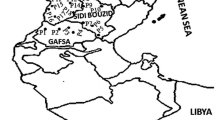Abstract
Genetic diversity among 45 genotypes of soybean (Glycine max (L.) Merr.) was assessed based on qualitative traits and 36 microsatellite markers. Forty-five genotypes were characterized for eleven morphological traits: leaf shape, leaf intensity of green colour, leaf size of lateral leaflet, plant growth habit, variation in hilum colour, cotyledon/flower colour, hairiness, hair colour, pod colour, testa colour and seed shape. Principal component analysis revealed that genotypes, namely JS-95-60, JS-20-103, JS20-69, JS-20-114, JS-20-49 and JS-335, were diverged from each other, and the range of polymorphic information content for microsatellite markers was 0.018–0.580. With 27 polymorphic SSR markers, a total of 71 alleles were amplified with an average of 1.97 alleles per locus. Eleven alleles were found to be unique to 45 genotypes. Soybean genotypes distributed in two clusters revealed diverse genetic background. Overall, the present study paves the way for better characterization of soybean genotypes and confirms India as one of the important centres of soybean domestication containing valuable genetically important assets for soybean improvement.




Similar content being viewed by others
References
Bisen A, Khare D, Nair P, Tripathi N (2015) SSR analysis of 38 genotypes of soybean (Glycine max (L.) Merr.) Genetic diversity in India. Physiol Mol Biol Plants 21:109–115
Brown-Guedira GL, Thompson JA, Nelson RL, Warburton ML (2000) Evaluation of genetic diversity of soybean introductions and North American ancestors using RAPD and SSR markers. Crop Sci 40:815–823
Cupic T, Tucak M, Popovic S, Bolaric S, Grljusic S, Kozumplik V (2009) Genetic diversity of pea (Pisum sativum L.) genotypes assessed by pedigree, morphological and molecular data. J Food Agric Environ 7:343–348
Dong D, Fu X, Yuan F, Chen P, Zhu S, Li B, Yang Q, Yu X, Zhu D (2014) Genetic diversity and population structure of vegetable soybean (Glycine max (L.) Merr.) in China as revealed by SSR markers. Genet Resour Crop Evol 61:173–183
Faisal AM, Muhammad A, Afsari SQ, Muhammad RK (2011) Investigation and comparison of some morphological traits of the soybean populations using cluster analysis. Pak J Bot 43:1249–1255
Gawande PP, Patil S, Mayakumari, Bailkiwad VJ (2002) Selection of superior germplasm lines of soybean Glycine max (L.) Merrill for breeding. J Soils Crops 12(2):236–240
Giancola SS, Poltri M, Lacaze P, Hopp HE (2002) Feasibility of integration of molecular markers and morphological descriptors in a real case study of a plant variety protection system for soybean. Euphytica 127:95–113
Guan R, Chang R, Li Y, Wang L, Liu Z, Qiu L (2010) Genetic diversity comparison between Chinese and Japanese soybeans (Glycine max (L.) Merr.) revealed by nuclear SSRs. Genet Resour Crop Evol 57:229–242
Hammer O, Harper DAT, Ryan PD (2001) PAST: paleontological statistics software package for education and data analysis. Palaeontol Electron 4:1–9
Jolliffe IT (2002) Principal component analysis, 2nd edn. Springer, New York
Kumar D, Raje RS, Singh AK, Singh AM, Pandey A, Singh NK (2015) Assessment of genetic diversity based on agro-morphological traits and genic microsatellite markers in inter-specific derivatives andcultivars of pigeonpea. Indian J Genet 75(2):215–224
Kumawat G, Singh G, Gireesh C, Shivakumar M, Arya M, Agarwal DK, Husain SM (2015) Molecular characterization and genetic diversity analysis of soybean (Glycine max (L.) Merr.) germplasm accessions in India. Physiol Mol Biol Plants 21:101–107
Li X, Yan W, Agrama H, Hu B, Jia L, Jia M, Jackson A, Moldenhauer K, Mcclung A, Wu D (2010) Genotypic and phenotypic characterization of genetic differentiation and diversity in the USDA rice mini-core collection. Genetica 138:1221–1230
Liu K, Muse SV (2005) Powermarker: an integrated analysis environment for genetic marker analysis. Bioinform 21:2128–2129
Malik FA, Ashraf M, Qureshi AS, Khan MR (2011) Investigation and comparison of some morphological traits of the soybean populations using cluster analysis. Pak J Bot 43(2):1249–1255
Narvel JM, Fehr WR, Chu W, Grant D, Shoemaker RC (2000) Simple sequence repeat diversity among soybean plant introductions and elite genotypes. Crop Sci 40:1452–1458
Nei M (1973) Analysis of gene diversity in subdivided populations. Proc Natl Acad Sci USA 70:3321–3323
NSP IARI (2003) Morphological, chemical and electrophoretic descriptors for soybean. National seed project, IARI, New Delhi, Technical bulletin no. 15
Peakall R, Smouse PE (2006) GENALEX6: genetic analysis in Excel. Population genetic software for teaching and research. Mol Ecol 6:288–295
Peric V, Nicolic A, Babac V, Sudaric A, Srebric M, Dordevic V, Drinic SM (2014) Genetic relatedness of soybean genotypes based on agromorphological traits and RAPD markers. Genetika 46:839–854
Rohlf FJ (2000) NTSYS-pc: numerical taxonomy and multivariate analysis system, Version 2.2. Exeter software. Setauket, New York
Saghai-Maroof MA, Soliman KM, Jorgensen RA, Allard RW (1984) Ribosomal DNA spacer length polymorphism in barley: mendelian inheritance, chromosomal location and population dynamics. Proc Natl Acad Sci USA 81:8014–8018
Salimi S, Samiezade HL, Abadi GM, Salimi S, Salaheddin M (2012) Genetic diversity in soybean genotypes under drought stress condition using factor analysis and cluster analysis. World Appl Sci J 16(4):474–478
Shannon CE, Weaver W (1949) The mathematical theory of communication. University of Illinois Press, Urbana
Singh RK, Mishra SK, Singh SP, Mishra N, Sharma ML (2010) Evaluation of microsatellite markers for genetic diversity analysis among sugarcane species and commercial hybrid. Aust J Crop Sci 4:115–124
Tantasawat P, Trongchuen J, Prajongjai T, Jenweerawat S, Chaowiset W (2011) SSR analysis of soybean (Glycine max (L.) Merr.) genetic relationship and variety identification in Thailand. Aust J Crop Sci 5:283–290
UPOV, TG/80/6 (1998) Guidelines for the conduct of tests for distinctness, uniformity and stability: Soya bean (Glycine max (L.) Merr.). International Union for the Protection of New Varieties of Plants. Geneva, Switzerland. https://www.upov.int/edocs/tgdocs/en/tg080.pdf
Funding
Funding was provided by Jawaharlal Nehru Agriculture University, Jabalpur, India.
Author information
Authors and Affiliations
Corresponding author
Additional information
Publisher's Note
Springer Nature remains neutral with regard to jurisdictional claims in published maps and institutional affiliations.
Rights and permissions
About this article
Cite this article
Kachare, S., Tiwari, S., Tripathi, N. et al. Assessment of Genetic Diversity of Soybean (Glycine max) Genotypes Using Qualitative Traits and Microsatellite Markers. Agric Res 9, 23–34 (2020). https://doi.org/10.1007/s40003-019-00412-y
Received:
Accepted:
Published:
Issue Date:
DOI: https://doi.org/10.1007/s40003-019-00412-y




